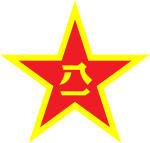
Back Vuurpylmag van die Volksbevrydingsleër Afrikaans قوة الصواريخ لجيش التحرير الشعبي Arabic Fuercia de Misiles del Exércitu Popular de Lliberación AST Втори артилерийски корпус Bulgarian পিপলস লিবারেশন আর্মি রকেট ফোর্স Bengali/Bangla Força de Míssils de l'Exèrcit Popular d'Alliberament Catalan Raketentruppe der chinesischen Volksbefreiungsarmee German Fuerza de Misiles del Ejército Popular de Liberación Spanish نیروی موشکی ارتش آزادیبخش خلق Persian Kansan vapautusarmeijan strategiset ohjusjoukot Finnish
| People's Liberation Army Rocket Force | |
|---|---|
| 中国人民解放军火箭军 | |
 Emblem of the People's Liberation Army Rocket Force | |
| Active | 1 July 1966 |
| Country | |
| Allegiance | |
| Type | Tactical and strategic missile force |
| Role | Strategic deterrence Second strike |
| Size | 300,000 active personnel |
| Part of | |
| Headquarters | Qinghe, Haidian, Beijing, China |
| March | 火箭军进行曲 ("March of the Rocket Force") |
| Equipment | |
| Engagements | |
| Website | Official website |
| Commanders | |
| Commander | General Wang Houbin |
| Political Commissar | General Xu Xisheng |
| Insignia | |
| Flag |  |
| Badge |  |
| Sleeve badge |  |
| People's Liberation Army |
|---|
 |
| Executive departments |
| Staff |
| Services |
| Arms |
| Domestic troops |
| Special operations forces |
| Military districts |
| History of the Chinese military |
| Military ranks of China |
The People's Liberation Army Rocket Force,[a] formerly the Second Artillery Corps,[b] is the strategic and tactical missile force of the People's Republic of China. The PLARF is the 4th branch of the People's Liberation Army (PLA) and controls China's arsenal of land-based ballistic, hypersonic, cruise missiles—both nuclear and conventional. The armed service branch was established on 1 July 1966 and made its first public appearance on 1 October 1984. The headquarters for operations is located at Qinghe, Beijing. The PLARF is under the direct command of the Chinese Communist Party's Central Military Commission (CMC).
The name was changed from the PLA Second Artillery Corps to the PLA Rocket Force on 1 January 2016.[2][3] Despite claims by some, there appears to be no evidence to suggest that the new generation of Chinese ballistic-missile submarines will come under PLARF control.[4][5]
The PLARF comprises approximately 300,000 personnel and six ballistic missile "Bases" (units at roughly corps or army group grade), plus 3 support Bases in charge of storage,[6] engineering, and training respectively. The six operational Bases are independently deployed in the five Theaters throughout China.[7][8] and each controls a number of brigades.[needs update]
China has the largest land-based missile arsenal in the world. According to United States Department of Defense estimates, this includes 400 ground-launched cruise missiles, 900 conventionally armed short-range ballistic missiles, 1,300 conventional medium-range ballistic missiles 500 conventional intermediate-range ballistic missiles, as well as 400 intercontinental ballistic missiles. Many of these are extremely accurate, which would allow them to destroy targets even without nuclear warheads.[9] The Bulletin of the Atomic Scientists and Federation of American Scientists estimated in 2023 that China has a stockpile of approximately 500 nuclear warheads,[10][11] while a 2024 United States Department of Defense estimate put the number of nuclear warheads at 600.[9]
- ^ "The PLA Oath" (PDF). Archived (PDF) from the original on 2016-05-09. Retrieved 2015-10-30.
I am a member of the People's Liberation Army. I promise that I will follow the leadership of the Communist Party of China...
- ^ "China's nuclear policy, strategy consistent: spokesperson". Beijing. Xinhua. 1 January 2016. Archived from the original on 8 October 2016. Retrieved 29 June 2019.
- ^ Fisher, Richard D. Jr. (6 January 2016). "China establishes new Rocket Force, Strategic Support Force". Jane's Defence Weekly. 53 (9). Surrey, England: Jane's Information Group. ISSN 0265-3818.
This report also quotes Chinese expert Song Zhongping saying that the Rocket Force could incorporate 'PLA sea-based missile unit[s] and air-based missile unit[s]'.
- ^ Medcalf, Rory (2020). The Future of the Undersea Deterrent: A Global Survey. Acton, ACT: National Security College, The Australian National University. pp. 26–27. ISBN 978-1-925084-14-6. Archived from the original on 2020-04-13. Retrieved 2020-05-23.
- ^ Logan, David C.; Center for the Study of Chinese Military Affairs (Institute for National Strategic Studies at National Defense University) (2016). "China's Future SSBN Command and Control Structure". Strategic Forum (299). Washington, D.C.: NDU Press: 2–3. OCLC 969995006. Archived from the original on 2020-10-30. Retrieved 2020-05-23.
- ^ Ma, Xiu (2021). "PLA Rocket Force Organization" (PDF). Air University. CASI. Retrieved 2024-05-22.
- ^ Kristensen, Hans M.; Korda, Matt (2019-07-04). "Chinese nuclear forces, 2019". Bulletin of the Atomic Scientists. 75 (4): 171–178. Bibcode:2019BuAtS..75d.171K. doi:10.1080/00963402.2019.1628511. ISSN 0096-3402. S2CID 198708540.
- ^ Mihal, Maj. Christopher J. (Summer 2021). "Understanding the People's Liberation Army Rocket Force Strategy, Armament, and Disposition" (PDF). Military Review (July–August 2021): 24–26. Archived (PDF) from the original on 2022-07-23. Retrieved 2022-08-26 – via Army University Press.
- ^ a b "2024 China Military Power Report". U.S. Department of Defense. Retrieved 2024-12-23.
- ^ Kristensen, Hans M.; Korda, Matt; Reynolds, Eliana (2023-03-04). "Chinese nuclear weapons, 2023". Bulletin of the Atomic Scientists. 79 (2): 108–133. Bibcode:2023BuAtS..79b.108K. doi:10.1080/00963402.2023.2178713. ISSN 0096-3402.
- ^ "Status of World Nuclear Forces". Federation of American Scientists. March 31, 2023. Archived from the original on May 29, 2023. Retrieved 2023-05-29.
Cite error: There are <ref group=lower-alpha> tags or {{efn}} templates on this page, but the references will not show without a {{reflist|group=lower-alpha}} template or {{notelist}} template (see the help page).